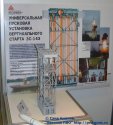VLS for ship weapons seem to be the hype these days, but how about a vertical launched weapon for the individual ground vehicle? So far, I can't find any sort of VLS for ground units on the Internet, so I will like discuss the feasibility of such system here.
What I have in mind is some sort of cold launched rocket munition with a EFP/HEAT warhead. The munition is fired through a top hatch on an AFV from an autoloading system in the hull, launched vertically up into the air. At perhaps 50-70 metres, sensors on the side of the VLGM will search for targets designated by a laser designator. Once it acquires a target, the rocket motor fires and the weapon follows a mortar-like trajectory towards it's target, guided by fins (or thrusters as in the XM395 Precision Guided Mortar Munition). Terminal homing will be achieved either by the initial SACLOS system or self-homing millimeter wave/infrared homing system.
Such a system will bear a few advantages over traditional direct-attack weapons like tank guns and LOS missiles:
The main advantages here are being able firing behind cover, no need to aim the weapon, top-attack capabilities, and having reduced size profile for the carrier vehicle. If augmented with datalink fire control system, versatility is greatly increase compare to conventional vehicle weapons. However, there are also some distinct disadvantages with a VLGM weapon compare to a conventional tank gun or wire-guided missile.
I look forward to hearing points from other people :china:.
Edit: Also, can the PLA potentially develop such a weapon?
What I have in mind is some sort of cold launched rocket munition with a EFP/HEAT warhead. The munition is fired through a top hatch on an AFV from an autoloading system in the hull, launched vertically up into the air. At perhaps 50-70 metres, sensors on the side of the VLGM will search for targets designated by a laser designator. Once it acquires a target, the rocket motor fires and the weapon follows a mortar-like trajectory towards it's target, guided by fins (or thrusters as in the XM395 Precision Guided Mortar Munition). Terminal homing will be achieved either by the initial SACLOS system or self-homing millimeter wave/infrared homing system.
Such a system will bear a few advantages over traditional direct-attack weapons like tank guns and LOS missiles:
- the VLGM's characteristics essentially turns it into a top-attack weapon against armor vehicles.
- Unlike a conventional gun/missile system, you do not need to transverse a big turret or barrel as the munition is self guiding. Reaction and engagement time will hence be reduced.
- Vehicle weight and profile can be smaller for a VLGM vehicle, as turrets, barrels, recoil system, etc... are discarded. A VLGM-armed tank can essentially be just a hull chasis.
- The VLGM equipped vehicle can engage the enemy safely behind cover or targets hiding behind cover.
- If a SACLOS system is used such as laser-designation, friendly infantry or vehicles can be directly linked to the VLGM vehicle and operate it as a short range tactical artillery against targets. An added benefit is that the carrier vehicle does not need to expose itself to enemy fire when launching the munitions in support.
The main advantages here are being able firing behind cover, no need to aim the weapon, top-attack capabilities, and having reduced size profile for the carrier vehicle. If augmented with datalink fire control system, versatility is greatly increase compare to conventional vehicle weapons. However, there are also some distinct disadvantages with a VLGM weapon compare to a conventional tank gun or wire-guided missile.
- The high trajectory means the munition will take quite a while to reach it's target compare to a high velocity tank round or LOS missile. During that time, the enemy can evade or launch countermeasures. One solution is to have the VLGM sharply "right-angle" itself after acquiring a target and fly towards its target at a flatter trajectory.
- A very complex guidance system will be needed to allow the munition to search and lock onto it's target. Adding the guidance package to the VLGM may mean a smaller warhead (less firepower) and larger munition (reduced ammunition capacity) compare to a 120mm tank round.
- As with any guided munition, they can be jammed. The carrier vehicle will most likely have a minimal radius where it can engage targets. Though, this can be solve by arming the vehicle with cannons or MGs as secondary weapons.
- The cost of a VLGM system will be high compare to tank guns and LOS missiles. Will such a expensive weapon be needed when a cheaper 120mm tank round will do?
- Complexity, how will a complicated VLGM system hold out in a combat environment? What will its logistic implementations be?
I look forward to hearing points from other people :china:.
Edit: Also, can the PLA potentially develop such a weapon?

